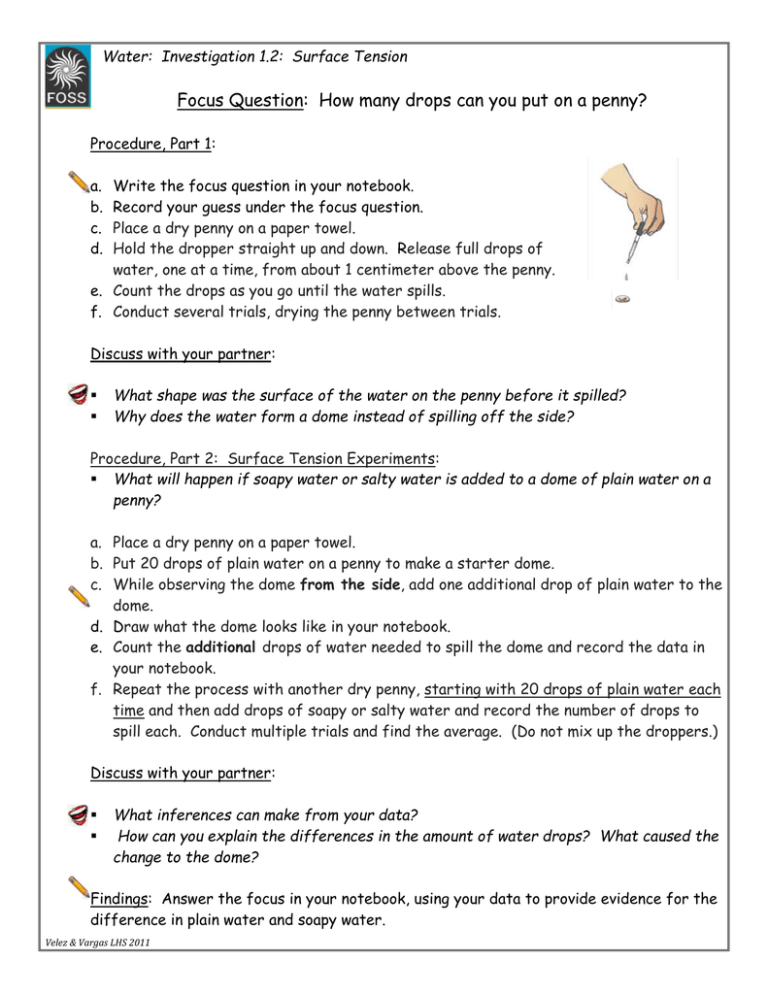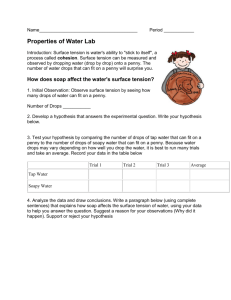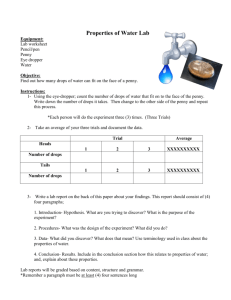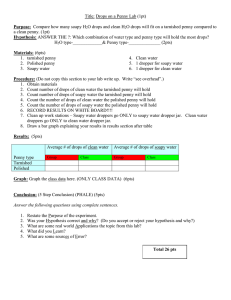Focus Question: How many drops can you put on...
advertisement

Water: Investigation 1.2: Surface Tension Focus Question: How many drops can you put on a penny? Procedure, Part 1: a. b. c. d. Write the focus question in your notebook. Record your guess under the focus question. Place a dry penny on a paper towel. Hold the dropper straight up and down. Release full drops of water, one at a time, from about 1 centimeter above the penny. e. Count the drops as you go until the water spills. f. Conduct several trials, drying the penny between trials. Discuss with your partner: What shape was the surface of the water on the penny before it spilled? Why does the water form a dome instead of spilling off the side? Procedure, Part 2: Surface Tension Experiments: What will happen if soapy water or salty water is added to a dome of plain water on a penny? a. Place a dry penny on a paper towel. b. Put 20 drops of plain water on a penny to make a starter dome. c. While observing the dome from the side, add one additional drop of plain water to the dome. d. Draw what the dome looks like in your notebook. e. Count the additional drops of water needed to spill the dome and record the data in your notebook. f. Repeat the process with another dry penny, starting with 20 drops of plain water each time and then add drops of soapy or salty water and record the number of drops to spill each. Conduct multiple trials and find the average. (Do not mix up the droppers.) Discuss with your partner: What inferences can make from your data? How can you explain the differences in the amount of water drops? What caused the change to the dome? Findings: Answer the focus in your notebook, using your data to provide evidence for the difference in plain water and soapy water. Velez & Vargas LHS 2011 Language Objective: Students will observe how water forms a dome on the surface of a penny, record how many water drops will fit on a penny, observe how soapy and salty water affect the shape of the dome, and explain the property of surface tension of water. Trial 1 Plain water Soapy Water Salty Water Trial 2 Trial 3 Average Vocabulary: Dome Surface tension Cohesion Water molecules Oxygen Hydrogen English Language Development: Explain that water molecules are attracted to other water molecules. The oxygen end of water has a negative charge and the hydrogen end has a positive charge. The hydrogen atoms of one water molecule are attracted to the oxygen atoms from other water molecules. This attractive force is what gives water its cohesive properties. Surface tension refers to the cohesion of water molecules at the surface of a body of water. The cohesion of water molecules forms a surface "film" or “skin.” Show students the model of a water drop and have them discuss with their partners the difference between the water molecules in the center and those on the surface. In their notebooks, students draw the model and explain how it relates to the water domes they made on the pennies. Essential Question: What are water’s unique physical and chemical properties? Application at Grade 7: How does an aquatic environment support different varieties of organisms? Investigation Materials: 4 Droppers 4 Small plastic cups 1 Tray 6 Pennies * 2 Self-stick notes 2 Pitchers 1 Spoon, 5 mL • Rock salt • Liquid dishwashing detergent (5–10 mL) * • Paper towels * • White vinegar, 200 mL * • Water * Velez & Vargas LHS 2011 TEKS for Physical Science: matter has physical and chemical properties and can undergo physical and chemical changes TEKS for Life Sciene: investigate and explain how internal structures of organisms have adaptations that allow specific functions such as gills in fish, hollow bones in birds, or xylem in plants; differentiate between structure and function in plant and animal cell organelles, including cell membrane, cell wall, nucleus, cytoplasm, mitochondrion, chloroplast, and vacuole; observe and describe how different environments, including microhabitats in schoolyards and biomes, support different varieties of organisms TEKS for ELL’s: Vocabulary needs to be taught in the context of connected discourse so that language is meaningful. At the same time English learners are learning in English, the focus is on academic English, concepts, and the language structures specific to the content.



